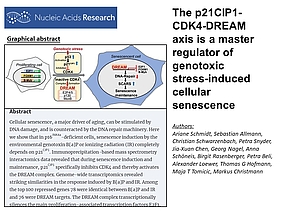New joint publication by the Beli, Christmann and Hofmann labs on how the p21CIP1-CDK4-DREAM axis is a master regulator of genotoxic stress-induced cellular senescence
Schmidt A, Allmann S, Schwarzenbach C, Snyder P, Chen J, Nagel G, Schöneis A, Rasenberger B, Beli P, Loewer A, Hofmann T, Tomicic M, Christmann M (2024) The p21CIP1-CDK4-DREAM axis is a master regulator of genotoxic stress-induced cellular senescence.Nucleic Acids Research, doi: 10.1093/nar/gkae426
Abstract:
Cellular senescence, a major driver of aging, can be stimulated by DNA damage, and is counteracted by the DNA repair machinery. Here we show that in p16INK4a-deficient cells, senescence induction by the environmental genotoxin B[a]P or ionizing radiation (IR) completely depends on p21CIP1. Immunoprecipitation-based mass spectrometry interactomics data revealed that during senescence induction and maintenance, p21CIP1 specifically inhibits CDK4 and thereby activates the DREAM complex. Genome-wide transcriptomics revealed striking similarities in the response induced by B[a]P and IR. Among the top 100 repressed genes 78 were identical between B[a]P and IR and 76 were DREAM targets. The DREAM complex transcriptionally silences the main proliferation-associated transcription factors E2F1, FOXM1 and B-Myb as well as multiple DNA repair factors. Knockdown of p21CIP1, E2F4 or E2F5 diminished both, repression of these factors and senescence. The transcriptional profiles evoked by B[a]P and IR largely overlapped with the profile induced by pharmacological CDK4 inhibition, further illustrating the role of CDK4 inhibition in genotoxic stress-induced senescence. Moreover, data obtained by live-cell time-lapse microscopy suggest the inhibition of CDK4 by p21CIP1 is especially important for arresting cells which slip through mitosis. Overall, we identified the p21CIP1/CDK4/DREAM axis as a master regulator of genotoxic stress-induced senescence.
Read the full paper here: https://academic.oup.com/nar/advance-article/doi/10.1093/nar/gkae426/7680627

